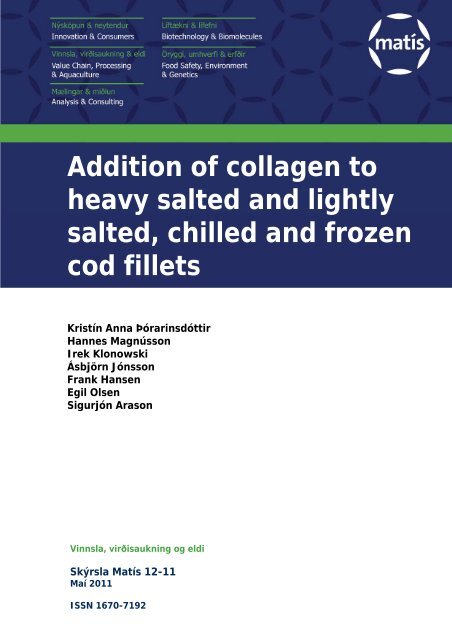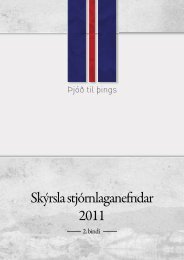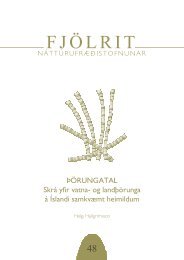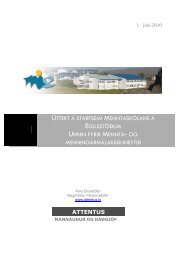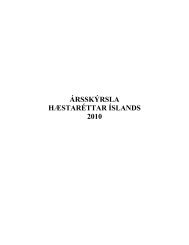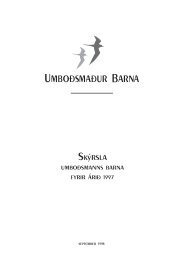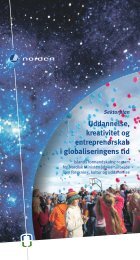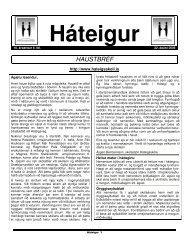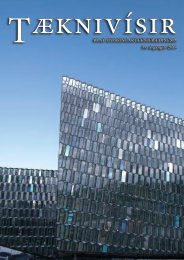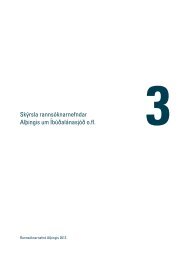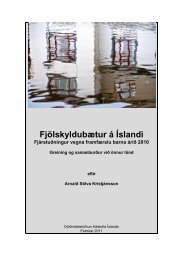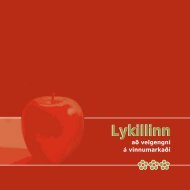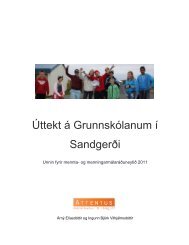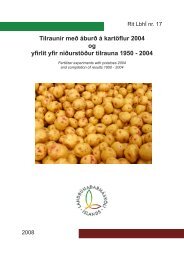Addition of collagen to heavy salted and lightly salted, chilled and ...
Addition of collagen to heavy salted and lightly salted, chilled and ...
Addition of collagen to heavy salted and lightly salted, chilled and ...
You also want an ePaper? Increase the reach of your titles
YUMPU automatically turns print PDFs into web optimized ePapers that Google loves.
<strong>Addition</strong> <strong>of</strong> <strong>collagen</strong> <strong>to</strong><br />
<strong>heavy</strong> <strong>salted</strong> <strong>and</strong> <strong>lightly</strong><br />
<strong>salted</strong>, <strong>chilled</strong> <strong>and</strong> frozen<br />
cod fillets<br />
Kristín Anna Þórarinsdóttir<br />
Hannes Magnússon<br />
Irek Klonowski<br />
Ásbjörn Jónsson<br />
Frank Hansen<br />
Egil Olsen<br />
Sigurjón Arason<br />
Vinnsla, virðisaukning og eldi<br />
Skýrsla Matís 12-11<br />
Maí 2011<br />
ISSN 1670-7192
Titill / Title<br />
<strong>Addition</strong> <strong>of</strong> <strong>collagen</strong> <strong>to</strong> <strong>heavy</strong> <strong>salted</strong> <strong>and</strong> <strong>lightly</strong> <strong>salted</strong>,<br />
<strong>chilled</strong> <strong>and</strong> frozen cod fillets<br />
Höfundar / Authors Kristín Anna Þórarinsdóttir 1 , Hannes Magnússon 1 , Irek Klonowski 1<br />
Ásbjörn Jónsson 1 , Frank Hansen 2 , Egil Olsen 3 , Sigurjón Arason 1<br />
Affiliation: 1 Matis, 2 Hansen & Øye Consulting, 3 Delta Seafood/MVL<br />
Skýrsla nr. / Report no. 12‐11 Útgáfudagur / Date: Maí 2011<br />
Verknr. / project no. 2002‐2026<br />
Styrktaraðilar / funding: NORA<br />
Ágrip á íslensku:<br />
Áhrif viðbætts gelatíns sem unnið var úr fiski, voru könnuð á nýtingu,<br />
efnasamsetningu og gæði kældra, frystra og saltaðra þorskflaka.<br />
Gelatíninu var bl<strong>and</strong>að í saltpækil sem síðan var sprautað í flökin. Söltuð<br />
flök voru pækluð eftir sprautun, síðan þurrsöltuð í 3 vikur og að lokum<br />
útvötnuð. Til samanburðar voru notuð flök sem sprautuð voru eingöngu<br />
með saltpækli.<br />
Meginniðurstöður voru þær að áhrif gelatíns á nýtingu og<br />
efnasamsetningu væru óveruleg. Breytingar voru fyrst og fremst af<br />
völdum hækkaðs saltinnihalds. Öðru máli gegndi um skemmdarferla í<br />
kældum afurðum. Örveruvöxtur og myndun niðurbrotsefna var meiri í<br />
þeim flökum sem sprautuð voru með gelatíni. Ekki var þó hægt að greina<br />
sjónrænan mun á útliti flaka eftir samsetningu pækils.<br />
Lykilorð á íslensku:<br />
Summary in English:<br />
Þorskur, gelatine, sprautun, nýting, gæði<br />
The effects <strong>of</strong> added fish gelatine on yield, chemical composition <strong>and</strong><br />
quality <strong>of</strong> <strong>chilled</strong>, frozen <strong>and</strong> <strong>salted</strong> cod fillets were evaluated. The<br />
gelatine was mixed with salt brine <strong>and</strong> injected <strong>to</strong> the fillets. Salted fillets<br />
were brined after injection, dry <strong>salted</strong> for 3 weeks <strong>and</strong> finally<br />
rehydrated. Fillets injected only with salt brine were used as control.<br />
Effects <strong>of</strong> added gelatine on yield <strong>and</strong> chemical composition were not<br />
significant. Alterations were primarily due <strong>to</strong> the increased salt content<br />
by injection. Conversely, the growth <strong>of</strong> microorganisms <strong>and</strong> degradation<br />
within <strong>chilled</strong> fillets was accelerated by addition <strong>of</strong> gelatine. However, no<br />
significant differences were observed in visual appearance <strong>of</strong> the fillets.<br />
English keywords:<br />
Cod, gelatine, injection, yield, quality<br />
© Copyright Matís ohf / Matis ‐ Food Research, Innovation & Safety
Contents<br />
Objectives ................................................................................................................................................ 1<br />
Material <strong>and</strong> methods ............................................................................................................................. 2<br />
Experimental design ............................................................................................................................ 2<br />
Raw material ....................................................................................................................................... 3<br />
Processing ............................................................................................................................................ 3<br />
Weighing .............................................................................................................................................. 4<br />
Sampling .............................................................................................................................................. 4<br />
Weight changes <strong>and</strong> cooking yield ...................................................................................................... 4<br />
Analysis <strong>of</strong> chemical composition ....................................................................................................... 5<br />
Water holding capacity ....................................................................................................................... 5<br />
Microbial analysis ................................................................................................................................ 5<br />
Analysis <strong>of</strong> TVB‐N <strong>and</strong> TMA ................................................................................................................. 6<br />
Analysis <strong>of</strong> TBARS ................................................................................................................................ 6<br />
Measurement <strong>of</strong> pH ............................................................................................................................ 6<br />
Statistical analysis <strong>of</strong> data ................................................................................................................... 6<br />
Results <strong>and</strong> discussion ............................................................................................................................. 7<br />
Raw fillets ........................................................................................................................................ 7<br />
Chilled fillets .................................................................................................................................... 7<br />
Frozen fillets .................................................................................................................................. 12<br />
Salted fillets ................................................................................................................................... 13<br />
Conclusion ............................................................................................................................................. 15<br />
Acknowledgement ................................................................................................................................. 15<br />
References ............................................................................................................................................. 16
Objectives<br />
The main objective <strong>of</strong> this study was <strong>to</strong> investigate if <strong>and</strong> how gelatine produced from by‐products <strong>of</strong><br />
cold water fish species could be used for injection <strong>to</strong> fish products. The gelatine was injected in<strong>to</strong><br />
cod fillets <strong>and</strong> the effects on weight <strong>and</strong> quality <strong>of</strong> <strong>chilled</strong>, frozen <strong>and</strong> <strong>salted</strong> cod fillets investigated in<br />
relation <strong>to</strong> following questions:<br />
• Does the addition <strong>of</strong> gelatine increase weight yields?<br />
• Are influences on chemical composition significant?<br />
• How is the shelf life <strong>and</strong> quality affected (microbial <strong>and</strong> chemical analysis)?<br />
• Are there visual differences in the appearance <strong>of</strong> the products?<br />
The aim was <strong>to</strong> use the results described in this report <strong>to</strong> identify possibilities in utilisation <strong>of</strong> the<br />
gelatine for processing <strong>of</strong> commercial fish products, with regard <strong>to</strong> potential buyers, prices <strong>and</strong><br />
markets.<br />
1
Material <strong>and</strong> methods<br />
Experimental design<br />
Fillets were injected with brine without (salt) <strong>and</strong> with addition <strong>of</strong> gelatine (salt+gelatine). The fillets<br />
were then s<strong>to</strong>red as <strong>chilled</strong>, frozen <strong>and</strong> <strong>heavy</strong> <strong>salted</strong> (Figure 1).<br />
Figure 1. Experimental plan, fillets were injected with salt or with brine containing both salt <strong>and</strong> gelatine.<br />
After that different preservation methods were applied, chilling, freezing <strong>and</strong> further salting.<br />
Parameters evaluated in fillets treated by different methods are listed in Table 2. Microbial growth<br />
was evaluated under aerobic <strong>and</strong> anaerobic conditions.<br />
Table 1. Parameters evaluated in the experiments<br />
Parameters Chilled Frozen Salted<br />
Weight changes during processing <strong>and</strong> s<strong>to</strong>rage x x x<br />
Cooking yield x x<br />
Fat content (Soxhlet, Bligh <strong>and</strong> Dyer), PV, TBA x c<br />
Microbial growth (TVC, H 2 S), TVB, TMA<br />
x<br />
2
Raw material<br />
Cod (Gadus morhua) was caught on the 8th <strong>of</strong> March, 2011, in Ísafjarðardjúp on long‐line. The fish<br />
was bled on board <strong>and</strong> s<strong>to</strong>red in ice, in tubs during transport <strong>to</strong> Reykjavík. On 9th <strong>of</strong> March, the fish<br />
was gutted, beheaded <strong>and</strong> filleted. The average weight <strong>of</strong> the fillets was 264.8 ± 37.5.<br />
Coarse salt ESCO Fishery salt K 3.2‐0.4, European Salt Company GmbH & Co.KG, Hannover, Germany)<br />
was used for the procedures applied. Specifications are shown in Table 2.<br />
Dried fish gelatine (high molecular weight) was used in the process for injection <strong>to</strong> the fish fillets.<br />
The <strong>collagen</strong> was extracted from cod skin <strong>and</strong> coarsely filtered. Thereafter, ultrafiltered <strong>and</strong> vacuum<br />
dried.<br />
Table 2. Product data sheet for ESCO Fishery salt K 3,2‐0,4 (European Salt Company GmbH & Co.KG,<br />
Hannover, Germany).<br />
Processing<br />
The brine used for injection contained salt only (20% w/w) or salt (20% w/w) <strong>and</strong> gelatine (2% w/w).<br />
The fish was processed under <strong>chilled</strong> conditions (5‐10°C). In this temperature range, the solubility <strong>of</strong><br />
the gelatine is reduced, which caused some difficulties regarding the injection procedure. The<br />
gelatine already solubilised, precipitated when getting in contact with cold parts <strong>of</strong> the machine <strong>and</strong><br />
fish. The salt concentration <strong>of</strong> the brine did not cause problems in solubilisation <strong>of</strong> gelatine.<br />
The fillets were injected using a multi‐needle brine injec<strong>to</strong>r (Dorit INJECT‐O‐MAT, Model No. PSM‐<br />
42F‐3.0I, Dorit Fleischereimaschinen GmbH, Ellwangen, Germany) under 45 strokes per min <strong>and</strong> 20<br />
mm belt advance per stroke. The diameter <strong>of</strong> the needles (n=42) was 2 mm <strong>and</strong> the distance<br />
between needles was approximately 20 mm. The injection dept <strong>of</strong> the needles was 5.5 mm from<br />
getting through the fillets. The pressure was 2.2 bars.<br />
After injection, the fillets were divided in three groups for different preservation methods: Chilled,<br />
frozen <strong>and</strong> <strong>heavy</strong> <strong>salted</strong>.<br />
3
Chilled fillets: The fillets were packed in plastic bags <strong>and</strong> s<strong>to</strong>red in polystyrene boxes at 2°C until<br />
sampling <strong>to</strong>ok place.<br />
Frozen fillets: The fillets were packed in plastic bags in one layer <strong>and</strong> frozen in air <strong>and</strong> s<strong>to</strong>red at ‐24°C.<br />
After 19 days the fillets were thawed for 3 hours at room temperature (20°C) <strong>and</strong> over night at 2°C,<br />
covered with a plastic film.<br />
Salted fillets: The fillets were brine <strong>salted</strong> in a fish <strong>to</strong> brine ratio <strong>of</strong> 1:2 for 2 days. Then, they were<br />
dry <strong>salted</strong> for 21 days. The fillets were stacked with alternating layers <strong>of</strong> salt in plastic boxes, where<br />
the liquid was allowed <strong>to</strong> drain away from the fillets. After salting, the fillets were rehydrated in a<br />
ratio <strong>of</strong> 1:5 for 16 hours, <strong>and</strong> then the water was replaced with fresh water (ratio 1:5), for further<br />
rehydration for 72 hours.<br />
Weighing<br />
The fillets were weighed fresh <strong>and</strong> at each sampling point for evaluation <strong>of</strong> weight changes (yield).<br />
<strong>Addition</strong>ally, weight changes during cooking <strong>of</strong> frozen, thawed <strong>and</strong> <strong>salted</strong> fillets were recorded.<br />
Sampling<br />
Chilled fillets: Samples were collected from the raw material <strong>and</strong><br />
after 2, 5, 9, 13 days <strong>of</strong> s<strong>to</strong>rage. Two slices from different parts <strong>of</strong><br />
the fillet (n=3) were pooled for analysis <strong>of</strong> water holding capacity<br />
(WHC), water <strong>and</strong> salt content. The rest <strong>of</strong> the fillet was pooled for<br />
analysis <strong>of</strong> microbial growth, <strong>to</strong>tal volatile base nitrogen (TVB) <strong>and</strong><br />
trimethylamine (TMA).<br />
Frozen fillets: Two slices from different part <strong>of</strong> the fillet (n=3) were pooled for analysis <strong>of</strong> water<br />
holding capacity (WHC), water <strong>and</strong> salt content. The rest <strong>of</strong> the fillet was pooled for analysis <strong>of</strong> fat<br />
content, peroxide value (PV), <strong>and</strong> thiobarbituric acid reactive substances (TBARS).<br />
Salted fillets: Two slices from different part <strong>of</strong> the fillet (n=3) were pooled for analysis <strong>of</strong> water<br />
holding capacity (WHC), water <strong>and</strong> salt content. The rest <strong>of</strong> the fillet was pooled for analysis <strong>of</strong> fat<br />
content, PV, TBARS, TVB <strong>and</strong> TMA.<br />
Weight changes <strong>and</strong> cooking yield<br />
Fillets were allowed <strong>to</strong> drain for 10 min after injection <strong>and</strong> then weighed before s<strong>to</strong>rage or further<br />
processing. Weight changes were followed by recording the weight at each sampling point. The<br />
weight yield (%) was calculated as the relative mass <strong>of</strong> the weight <strong>of</strong> raw fillets (n=12).<br />
Chilled fillets: The weight <strong>of</strong> fillets (n=3) at each sampling point was recorded.<br />
Frozen fillets: The weight <strong>of</strong> frozen fillets (n=6) was recorded before <strong>and</strong> after thawing.<br />
4
Salted fillets: The weight was recorded after brining (n=9), after dry salting (n=6) <strong>and</strong> after<br />
rehydration (n=3).<br />
Drip loss (%) was expressed as relative weight reduction during thawing. Cooking yield (%) <strong>of</strong> frozen<br />
(n=3) <strong>and</strong> <strong>salted</strong> rehydrated fillets (n=3) was calculated from weight changes during cooking. Each<br />
fillet was placed on baking paper on a grid <strong>and</strong> cooked at 95‐100 °C for 10 min in a preheated<br />
conventional steam oven (Convotherm Elektrogeräte GmbH, Eglfing, Germany). After cooking,<br />
samples were allowed <strong>to</strong> cool at room temperature for 20 min, <strong>and</strong> then reweighed. The cooking<br />
yield (%) was calculated as the ratio <strong>of</strong> retained weight after cooking compared <strong>to</strong> the weight before<br />
cooking.<br />
Analysis <strong>of</strong> chemical composition<br />
Water content (%) <strong>of</strong> the fresh fish was determined according <strong>to</strong> ISO 6496 (1999). The salt content<br />
(%) was determined according <strong>to</strong> the AOAC Official Methods <strong>of</strong> analysis (AOAC 2000). The chemical<br />
analyses were carried out in a labora<strong>to</strong>ry where the procedures have been accredited by Swedish<br />
Board for Accreditation <strong>and</strong> Conformity Assessment (SWEDAC). The measurement uncertainty was ±<br />
0.4% <strong>and</strong> ± 0.1%, for analysis <strong>of</strong> water <strong>and</strong> salt content, respectively.<br />
Lipid content (%) was evaluated after extraction <strong>of</strong> lipids by two different solvent systems, Soxhlet<br />
(AOCS, 1998) <strong>and</strong> Bligh & Dyer (1959) with some modifications (Hanson <strong>and</strong> Olley, 1963). In Bligh &<br />
Dyer, extraction <strong>of</strong> lipids was carried out by chlor<strong>of</strong>orm/methanol extraction system <strong>and</strong> with<br />
butylated hydroxy<strong>to</strong>luene (BHT) admixed in<strong>to</strong> all solvents (50‐100 mg/L).<br />
Water holding capacity<br />
The WHC was determined by a centrifugation method (Eide <strong>and</strong> others 1982). The saithe samples<br />
(n=3) were coarsely minced in a mixer (Braun Electronic, Type 4262, Kronberg, Germany) for<br />
approximately 20 s at speed 4. Approximately 2 g <strong>of</strong> the minced saithe muscle was weighed<br />
accurately in<strong>to</strong> sample glass <strong>and</strong> centrifuged at 210 * g for 15 min. The weight <strong>of</strong> liquid expelled<br />
from the muscle during centrifugation was subtracted from the weight <strong>of</strong> water in the sample before<br />
centrifugation. The WHC was calculated as the ratio <strong>of</strong> the water remaining after centrifugation<br />
compared <strong>to</strong> the initial water content <strong>of</strong> the sample before centrifugation <strong>and</strong> expressed as % WHC.<br />
Microbial analysis<br />
Samples <strong>of</strong> 3 cod fillets were minced <strong>and</strong> 20 g weighed from each fillet in<strong>to</strong> 180 g <strong>of</strong> cooled<br />
Maximum Recovery Dilutent (MRD, Oxoid) <strong>and</strong> blended in a S<strong>to</strong>macher® Lab Blender 400 (Seward,<br />
UK) for 1 min <strong>to</strong> obtain 1/10 dilution. Cooled MRD was used for all subsequent dilutions. Total viable<br />
psychrotrophic counts (TVC) <strong>and</strong> counts <strong>of</strong> H2S‐producing bacteria were evaluated on iron agar (IA)<br />
as described by Gram <strong>and</strong> others (1987) with the exception that 1% NaCl was used instead <strong>of</strong> 0.5%<br />
with no overlay. Surface‐plating was used. Plates were incubated at 17°C for 5 days both aerobically<br />
<strong>and</strong> anaerobically in an anaerobic jar (Oxoid). Bacteria forming black colonies on IA produce H 2 S<br />
from sodium thiosulphate <strong>and</strong>/or cysteine.<br />
5
Analysis <strong>of</strong> TVBN <strong>and</strong> TMA<br />
Total volatile basic nitrogen (TVB‐N) <strong>and</strong> trimethylamine (TMA) were determined by the methods<br />
described by Malle <strong>and</strong> Poumeyrol (1989). The TVB‐N measurement was performed by direct<br />
distillation in<strong>to</strong> boric acid using a Kjeldahl‐type distilla<strong>to</strong>ry (Struer TVB‐N distilla<strong>to</strong>ry, STRUERS,<br />
Copenhagen, Denmark). The acid was back‐titrated with diluted H 2 SO 4 solution. To determine TMA,<br />
the same method was used as for TVB but adding 20 mL <strong>of</strong> 35% formaldehyde <strong>to</strong> the distillation flask<br />
<strong>to</strong> block the primary <strong>and</strong> secondary amines. The TVB <strong>and</strong> TMA contents were expressed in mg N/100<br />
g saithe tissue.<br />
Analysis <strong>of</strong> TBARS<br />
The quantity <strong>of</strong> secondary oxidation products was evaluated by analysis <strong>of</strong> TBARS (2‐thiobarbituric<br />
acid reactive substances). TBARS were determined as described by Vyncke (1970, 1975) with<br />
modifications by Sörensen <strong>and</strong> Jörgensen (1996). The sample size was reduced <strong>to</strong> 15 g <strong>of</strong> sample <strong>and</strong><br />
homogenised with 30 mL <strong>of</strong> 7.5% trichloroacetic acid (TCA) with 0.1% propylgallate <strong>and</strong> EDTA.<br />
Absorbance <strong>of</strong> samples <strong>and</strong> st<strong>and</strong>ards was measured at 530 nm in UV/VIS‐spectrometer. TBARS,<br />
expressed as µmol malondialdehyde per kilogram <strong>of</strong> sample (µmol MDA/kg) was calculated using<br />
malondialdehyd‐bis‐(diethyl acetate) as st<strong>and</strong>ard.<br />
Measurement <strong>of</strong> pH<br />
The pH was measured in 5 grams <strong>of</strong> minced loins mixed with 5 mL <strong>of</strong> deionised water using the<br />
Radiometer PHM 80. The pH meter was calibrated using the buffer solutions (Orion, Thermo Fisher<br />
Scientific, Beverly, MA 01915, USA) buffer <strong>of</strong> pH 7.00 ± 0.01 <strong>and</strong> 4.01 ± 0.01 (25°C) (Radiometer<br />
Analytical A/S, Bagsvaerd, Denmark).<br />
Statistical analysis <strong>of</strong> data<br />
Results are presented as average values ± st<strong>and</strong>ard deviation. Statistical analyses were carried out<br />
by t‐test (two‐way, assuming equal variances), general linear modelling (GLM) <strong>and</strong> Duncan’s<br />
Multiple‐Comparison test <strong>to</strong> evaluate effects <strong>of</strong> different treatments <strong>and</strong> s<strong>to</strong>rage times at each<br />
condition. The statistical analysis was performed using Micros<strong>of</strong>t Office Excel 2007 <strong>and</strong> NCSS 2000<br />
(NCSS, Kaysville, Utah, USA).<br />
6
Results <strong>and</strong> discussion<br />
Raw fillets<br />
The water content in fresh fillets was 82.8% (± 0.2), salt content 0.8% (± 0.1), lipid content‐Bligh &<br />
Dyer) 0.54 (± 0.05), lipid content‐Soxhlet 0.14 (±0.05), WHC 89.9% (± 2.0), pH 6.9 (±0.1), TBARS 2.4<br />
μmole/kg (± 0.4), TVB 8.04 mg N/100g (± 0.51) <strong>and</strong> TMA 1.13 mg N/100g (± 0.07). The fillets were<br />
<strong>chilled</strong> in the processing line with slurry ice, resulting in s<strong>lightly</strong> values for salt content than usually<br />
observed in fresh fish (0.2‐0.3%).<br />
Chilled fillets<br />
Yield<br />
The result indicated that the gelatine addition resulted in lower uptake <strong>and</strong> that weight yields were<br />
on average lower in comparison <strong>to</strong> fillets with only salt (GLM: p=0,000259).<br />
Fillets injected with salt (S) had higher uptake (p0.05)<br />
except after 13 days similar values were obtained. Effects <strong>of</strong> s<strong>to</strong>rage time were not significant.<br />
Yield (%)<br />
120<br />
118<br />
116<br />
114<br />
112<br />
110<br />
108<br />
106<br />
104<br />
102<br />
100<br />
Salt<br />
Salt + G<br />
0 1 2 3 4 5 6 7 8 9 10 11 12 13 14<br />
S<strong>to</strong>rage time (days)<br />
Figure 2. Weight changes <strong>of</strong> <strong>chilled</strong> fillets from injection (n=12) <strong>and</strong> at different sampling points (n=3) during<br />
<strong>chilled</strong> s<strong>to</strong>rage.<br />
Chemical composition<br />
Higher salt uptake (p
3.3–3.6% <strong>and</strong> 3.9‐4.3%, in Salt + G <strong>and</strong> Salt, respectively (Table 3). Changes in salt content with<br />
s<strong>to</strong>rage time were not significant (p >0.05).<br />
The water content was s<strong>lightly</strong> higher (p=0.08) in fillets with added gelatine. Higher content was<br />
determined with longer s<strong>to</strong>rage time (p0.05). The increases in WHC by higher salt content were in harmony with previous<br />
findings in muscle food. It is known that the WHC increases with increasing salt concentration within<br />
the muscle up <strong>to</strong> approximately 5%, due <strong>to</strong> binding <strong>of</strong> salt <strong>to</strong> muscle proteins <strong>and</strong> denaturation. At<br />
higher salt concentrations (>10‐12%), the proteins are known <strong>to</strong> aggregate, resulting in reduction <strong>of</strong><br />
WHC (Duerr <strong>and</strong> Dyer, 1952; Hamm, 1975; Offer <strong>and</strong> Knight, 1988; Offer <strong>and</strong> Trinick, 1983).<br />
Table 3. Chemical composition <strong>and</strong> water holding capacity <strong>of</strong> <strong>chilled</strong> fillets (n=3) at different sampling points<br />
(n=3) during <strong>chilled</strong> s<strong>to</strong>rage.<br />
S<strong>to</strong>rage time (days)<br />
Group 2 5 9 13<br />
Salt (%) Salt 4.3 ± 0.3 4.3 ± 0.0 3.8 ± 0.4 3.9 ± 0.1<br />
Salt + G 3.3 ± 0.1 3.3 ± 0.0 3.3 ± 0.2 3.6 ± 0.1<br />
Water (%) Salt 81.7 ± 0.6 81.5 ± 0.1 82.3 ± 0.2 82.3 ± 0.7<br />
Salt + G 81.9 ± 0.3 82.1 ± 1.0 82.5 ± 0.2 83.0 ± 0.7<br />
WHC (%) Salt 98,7 ± 0,4 99,3 ± 0,2 98,8 ± 0,1 98,8 ± 0,6<br />
Salt + G 98,8 ± 0,6 99,3 ± 0,1 98,7 ± 0,1 98,2 ± 0,4<br />
Microbial counts<br />
Results from <strong>to</strong>tal viable counts (TVC) <strong>and</strong> counts <strong>of</strong> H 2 S‐producing bacteria are shown in Figure 3<br />
<strong>and</strong> Figure 4. Very similar TVC were found whether plates were cultivated under aerobic or anaerobic<br />
conditions. This might indicate that the microbial flora was facultative anaerobic in nature, i.e. able<br />
<strong>to</strong> grow both in the presence <strong>and</strong> absence <strong>of</strong> oxygen. This was however not the case with H 2 S‐<br />
producing bacteria. The initial number <strong>of</strong> these bacteria under anaerobic conditions gradually<br />
decreased from about log 2‐3/g <strong>to</strong> levels below detection limits (
not clear. It is possible that some anaerobic bacteria recovered in the later days <strong>of</strong> s<strong>to</strong>rage in both<br />
experimental groups reaching numbers up <strong>to</strong> log 5/g as stated before. Under aerobic conditions, H 2 S‐<br />
producing bacteria increased in numbers in both groups during the s<strong>to</strong>rage time.<br />
9<br />
8<br />
7<br />
Log number/g<br />
6<br />
5<br />
4<br />
3<br />
2<br />
1<br />
0<br />
0 2 4 6 8 10 12 14<br />
S<strong>to</strong>rage time (days)<br />
IA‐TVC, aerobic, salt<br />
IA‐TVC, anaerobic, salt<br />
IA‐TVC, aerobic, salt + G<br />
IA‐TVC, anaerobic, salt + G<br />
Figure 3. Changes in <strong>to</strong>tal viable counts (TVC) <strong>chilled</strong> fillets, from injection (n=12) <strong>and</strong> at different sampling<br />
points (n=3) during <strong>chilled</strong> s<strong>to</strong>rage.<br />
Log number/g<br />
9<br />
8<br />
7<br />
6<br />
5<br />
4<br />
3<br />
2<br />
1<br />
0<br />
IA‐H2S, aerobic, salt<br />
IA‐H2S, anaerobic, salt<br />
IA‐H2S, aerobic, salt + G<br />
IA‐H2S, anaerobic, salt + G<br />
0 2 4 6 8 10 12 14<br />
S<strong>to</strong>rage time (days)<br />
Figure 4. Changes in counts <strong>of</strong> H 2 S‐producing bacteria <strong>chilled</strong> fillets, from injection (n=12) <strong>and</strong> at different<br />
sampling points (n=3) during <strong>chilled</strong> s<strong>to</strong>rage.<br />
9
The brine used for injection <strong>of</strong> fillets contained salt only (S) or salt <strong>and</strong> gelatine (Salt + G). The<br />
microbial counts were generally higher where gelatine was used (GLM results for aerobic conditions:<br />
p TVC =0.10, p H2S =0.06; GLM results for anaerobic conditions: p TVC =0.02, p H2S =0.27). This difference was<br />
noticeable in TVC on days 2, 5 <strong>and</strong> 9 at both aerobic <strong>and</strong> anaerobic conditions <strong>and</strong> at aerobic<br />
conditions during the whole s<strong>to</strong>rage period with regard <strong>to</strong> H 2 S‐producing bacteria. Similar but much<br />
lower counts were however found under anaerobic conditions in both experimental groups (salt with<br />
<strong>and</strong> without gelatine).<br />
The higher microbial counts in fillets with added gelatine may have resulted from microbial<br />
contamination in the gelatine <strong>and</strong>/or that the gelatine was an easily accessible substrate for the<br />
microorganisms, facilitating their growth. Further treatments <strong>to</strong> reduce microbial counts within the<br />
gelatine might be needed.<br />
TVB, TMA, pH<br />
Results from TVB <strong>and</strong> TMA measurements are shown in Figure 5. The results were in good harmony<br />
with microbial counts apart from anaerobic counts <strong>of</strong> H 2 S‐producing bacteria. As with microbial<br />
counts higher values were generally obtained in the samples which contained salt <strong>and</strong> gelatine in<br />
comparison with samples without gelatine (GLM p TVB =0.001; p TMA = 0.00008). The results indicated<br />
that addition <strong>of</strong> the gelatine, had negative effects on the shelf life <strong>and</strong> quality <strong>of</strong> the products.<br />
mgN/100g<br />
80<br />
70<br />
60<br />
50<br />
40<br />
30<br />
20<br />
10<br />
0<br />
TVB, salt<br />
TMA, salt<br />
TVB, salt + G<br />
TMA, salt + G<br />
0 2 4 6 8 10 12 14<br />
S<strong>to</strong>rage time (days)<br />
Figure 5. Changes in TVB <strong>and</strong> TMA content in <strong>chilled</strong> fillets from injection (n=12) <strong>and</strong> at different sampling<br />
points (n=3) during <strong>chilled</strong> s<strong>to</strong>rage.<br />
10
The pH values were in good conformity with microbial <strong>and</strong> chemical measurements Figure 6. After<br />
day 5 the pH values increased considerably. As expected from the microbial <strong>and</strong> chemical data,<br />
higher values were usually found in the experimental group containing gelatine (GLM p=0.20).<br />
7,7<br />
7,5<br />
pH units<br />
7,3<br />
7,1<br />
6,9<br />
6,7<br />
pH, salt<br />
pH, salt + G<br />
6,5<br />
0 2 4 6 8 10 12 14<br />
S<strong>to</strong>rage time (days)<br />
Figure 6. Changes in pH <strong>of</strong> <strong>chilled</strong> fillets from injection (n=12) <strong>and</strong> at different sampling points (n=3) during<br />
<strong>chilled</strong> s<strong>to</strong>rage.<br />
11
Frozen fillets<br />
Fillets injected with salt gained more weight by injection <strong>and</strong> maintained yield better through<br />
freezing, thawing <strong>and</strong> cooking. Differences between groups were significant at all stages (p
Salted fillets<br />
Higher uptake was obtained by injection <strong>of</strong> salt only but during brining <strong>and</strong> dry salting the yields <strong>of</strong><br />
the two groups became similar (Figure 8). After rehydration, higher yields were obtained for fillets<br />
with added gelatine.<br />
120<br />
115<br />
110<br />
Yield (%)<br />
105<br />
100<br />
95<br />
90<br />
85<br />
80<br />
Injected Brined Salted Rehydrated<br />
Salt<br />
Salt + G<br />
Figure 8. Weight changes <strong>of</strong> <strong>salted</strong> fillets from injection (n=6) <strong>to</strong> rehydration (n=3).<br />
Higher salt uptake was obtained after brining in fillets that were injected with salt only but during dry<br />
salting, differences levelled <strong>of</strong>f (Table 1). After rehydration similar values were obtained. Water<br />
contents in dry <strong>salted</strong> <strong>and</strong> rehydrated fillets were similar in both groups. The water holding capacity<br />
was also similar for the different treatments after brining <strong>and</strong> rehydration. However after dry salting<br />
the WHC <strong>of</strong> gelatine added fillets was higher. The amount <strong>of</strong> lipids was similar in both groups<br />
through the process. The level <strong>of</strong> oxidation was generally low, probably due <strong>to</strong> the short curing time.<br />
Stronger oxidation would have reduced the amount extracted by Blight & Dyer due <strong>to</strong> lipid<br />
degradation. Influences <strong>of</strong> gelatine addition on TVB <strong>and</strong> TMA were not significant. The contents in<br />
the <strong>salted</strong> fish were similar as in the raw material but decreased during rehydration. This has been<br />
explained be extraction or washing out <strong>of</strong> the nitrogenous compounds when the muscle is soaked in<br />
water.<br />
13
Table 5. Chemical composition <strong>and</strong> water holding capacity <strong>of</strong> injected, brined fillets, dry <strong>salted</strong> <strong>and</strong><br />
rehydrated fillets (n=3)<br />
Group Brined Dry <strong>salted</strong> Rehydrated<br />
Salt (%) Salt 11.5 ± 0.6 22.6 ± 0.1 2.8 ± 0.7<br />
Salt + G 9.9 ± 0.1 22.0 ± 0.2 2.9 ± 0.1<br />
Water (%) Salt 75.4 ± 0.4 60.5 ± 0.4 84.6 ± 0.4<br />
Salt + G 76.8 ± 0.3 60.4 ± 0.3 84.6 ± 0.7<br />
WHC (%) Salt 97.8 ± 0.5 59.2 ± 2.5 97.5 ± 2.1<br />
Salt + G 97.1 ± 0.3 65.9 ± 2.4 97.6 ± 1.1<br />
Lipid (B&D) (%) Salt 0.4 ± 0.1 0.4 ± 0.0 0.4 ± 0.0<br />
Salt + G 0.4 ± 0.0 0.4 ± 0.1 0.3 ± 0.0<br />
Lipid (Soxhlet) (%) Salt 0.1 ± 0.0 0.1 ± 0.0 0.1 ± 0.0<br />
Salt + G 0.1 ± 0.1 0.1 ± 0.0 0.1 ± 0.0<br />
TBARS (μmól/kg) Salt 2.6 ± 0.4 4.0 ± 0.7 3.3 ± 1.0<br />
Salt + G 3.8 ± 0.9 4.7 ± 0.5 3.1 ± 0.6<br />
TVB (mg N/100g) Salt 4.1 ± 0.9 8.4 ± 1.5 2.2 ± 0.2<br />
Salt + G 5.3 ± 0.3 7.1 ± 0.2 2.0 ± 0.1<br />
TMA (mg N/100g) Salt 0.3 ± 0.4 0.9 ± 0.0 N.D.<br />
Salt + G 0.8 ± 0.2 0.8 ± 0.2 N.D.<br />
N.D. quantities <strong>of</strong> TMA <strong>to</strong> low <strong>to</strong> be detected<br />
14
Conclusion<br />
In this experiment, the gains <strong>of</strong> gelatine addition were minor <strong>and</strong> its use had certain limitations in<br />
practice. The addition <strong>of</strong> gelatine <strong>to</strong> the cod fillets did not improve weight yields <strong>of</strong> the fillets. On<br />
the contrary, the uptake during injection was lower which was assumed <strong>to</strong> result from higher<br />
viscosity <strong>of</strong> the brine. Furthermore, the solubility <strong>of</strong> the gelatine at the low temperature (0‐5°C) is<br />
not high enough, which also causes problems. In processing <strong>of</strong> fish it is important <strong>to</strong> limit any<br />
temperature fluctuations as much as possible <strong>to</strong> reduce the risk <strong>of</strong> spoilage <strong>and</strong> shortening <strong>of</strong> shelf<br />
life. The salt concentration <strong>of</strong> the brine did not cause problems in solubilisation <strong>of</strong> gelatine.<br />
The main changes in chemical composition <strong>of</strong> the fillets were due <strong>to</strong> injection <strong>of</strong> the salt but not due<br />
<strong>to</strong> injection <strong>of</strong> gelatine.<br />
The addition <strong>of</strong> gelatine led <strong>to</strong> increases in microbial growth <strong>and</strong> in that aspect the use is negative for<br />
quality <strong>of</strong> the products. Visual comparison <strong>of</strong> the appearance <strong>of</strong> the fillets did not reveal differences<br />
between the groups. Further treatments <strong>to</strong> reduce microbial counts within the gelatine might be<br />
needed <strong>to</strong> obtained better results for the injected products.<br />
Acknowledgement<br />
The authors gratefully acknowledge the financial support <strong>of</strong> this work by NORA ( Journal nr. 210‐047;<br />
Project: “Injeksering av kollagen i fersk, frossen og <strong>salted</strong>e fiskefileter fra <strong>to</strong>rsk og sej (CIF)”).<br />
15
References<br />
AOAC 2000. 17th ed no.976.18. Measurement <strong>of</strong> salt in fish w/Tritrino ISO 6496 (1999). Method for<br />
analysing water in fish meal or fish. Official Methods <strong>of</strong> the Association <strong>of</strong> Official Chemists.<br />
Official Analytical Int, Arling<strong>to</strong>n VA.<br />
AOCS, American Oil Chemists Society. 1998. Official method BA 3‐38. Application note Teca<strong>to</strong>r nr AN<br />
301. In: Fires<strong>to</strong>ne D, edi<strong>to</strong>r. Official methods <strong>and</strong> recommended practices <strong>of</strong> the American Oil<br />
Chemists Society. 5th ed. Champaign, Ill.: AOCS, 4p.<br />
Bligh, E.G., Dyer, W.J. 1959. A rapid method <strong>of</strong> <strong>to</strong>tal lipid extraction <strong>and</strong> purification. Canadian<br />
Journal <strong>of</strong> Biochemistry <strong>and</strong> Physiology, 37: 911‐917.<br />
Duerr, J.D., Dyer, W.J. 1952. Proteins in fish muscle. IV. Denaturation by salt. Journal <strong>of</strong> the Fisheries<br />
Research Board <strong>of</strong> Canada, 8:, 325‐331.<br />
Eide O., Borresen T., Strom T., 1982. Minced fish production from capelin (Mallotus villosus). Journal<br />
<strong>of</strong> Food Science 47: 347–54.<br />
Gram L., Trolle G., Huss HH. 1987. Detection <strong>of</strong> specific spoilage bacteria from fish s<strong>to</strong>red at low (0°C)<br />
<strong>and</strong> high (20°C) temperatures. International Journal <strong>of</strong> Food Microbiology, 4:65‐72.<br />
Hamm, R. 1975. Water holding capacity <strong>of</strong> meat. In: Meat: proceedings <strong>of</strong> the twenty‐first Easter<br />
School in Agricultural Science, University <strong>of</strong> Nottingham, 1974 (pp. 321‐338): London:<br />
Butterworths.<br />
Hanson W.C. 1950. The pho<strong>to</strong>metric determination <strong>of</strong> phosphorus in fertilizers using the<br />
phosphovanadomolybdate complex. Journal <strong>of</strong> the Science <strong>of</strong> Food <strong>and</strong> Agriculture, 1:172‐<br />
173.<br />
Hanson, S.W.F., Olley, J. 1963. Application <strong>of</strong> the Bligh <strong>and</strong> Dyer method <strong>of</strong> lipid extraction <strong>to</strong> tissue<br />
homogenates. Journal <strong>of</strong> Biochemistry, 89: 101‐102P.<br />
ISO, Intl. Organisation for St<strong>and</strong>ardization, 6496‐1999(E), mod. Determination <strong>of</strong> moisture <strong>and</strong> other<br />
volatile matter content. Genf, Switzerl<strong>and</strong>: The Int’l Organization for St<strong>and</strong>ardization.<br />
Malle, P., <strong>and</strong> S.H. Tao, 1987. Rapid quantitative determination <strong>of</strong> Trimethylamine using steam<br />
distillation. Journal <strong>of</strong> Food Protection, 50: 756‐760.<br />
Offer, G., Knight, P. 1988. The structural basis <strong>of</strong> water‐holding in meat. Part 1: General principles<br />
<strong>and</strong> water uptake in meat processing. In: R. Lawrie, Developments in Meat Science ‐ 4 (pp.<br />
63‐171). London: Elsevier Applied Science.<br />
Offer, G., Trinick, J. 1983. On the mechanism <strong>of</strong> water holding in meat: The swelling <strong>and</strong> shrinking <strong>of</strong><br />
my<strong>of</strong>ibrils. Meat Science, 8:, 245‐281.<br />
Sørensen, G., Jørgensen, S.S. 1996. A critical examination <strong>of</strong> some experimental variables in the<br />
thiobarbituric acid (TBA) test <strong>of</strong> lipid oxidation in meat products. Zeitschrift für<br />
Lebensmitteluntersuchung und ‐Forschung A, 202: 205‐210.<br />
Vyncke, W. 1970. Direct determination <strong>of</strong> the thiobarbituric acid value in trichloroacitic acid extracts<br />
<strong>of</strong> fish as a measure <strong>of</strong> oxidative rancidity. Fette, Seifen, Anstrichmittel, 77: 239‐240.<br />
Vyncke, W. 1975. Evaluation <strong>of</strong> the Direct Thiobarbituric Acid Extraction Method for Determining<br />
Oxidative Rancidity in Mackerel (Scomber scombrus L.). European Journal <strong>of</strong> Lipid Science<br />
<strong>and</strong> Technology, 77: 205‐244.<br />
16
Contents<br />
Objectives ................................................................................................................................................ 1<br />
Material <strong>and</strong> methods ............................................................................................................................. 2<br />
Experimental design ............................................................................................................................ 2<br />
Raw material ....................................................................................................................................... 3<br />
Processing ............................................................................................................................................ 3<br />
Weighing .............................................................................................................................................. 4<br />
Sampling .............................................................................................................................................. 4<br />
Weight changes <strong>and</strong> cooking yield ...................................................................................................... 4<br />
Analysis <strong>of</strong> chemical composition ....................................................................................................... 5<br />
Water holding capacity ....................................................................................................................... 5<br />
Microbial analysis ................................................................................................................................ 5<br />
Analysis <strong>of</strong> TVB‐N <strong>and</strong> TMA ................................................................................................................. 6<br />
Analysis <strong>of</strong> TBARS ................................................................................................................................ 6<br />
Measurement <strong>of</strong> pH ............................................................................................................................ 6<br />
Statistical analysis <strong>of</strong> data ................................................................................................................... 6<br />
Results <strong>and</strong> discussion ............................................................................................................................. 7<br />
Raw fillets ........................................................................................................................................ 7<br />
Chilled fillets .................................................................................................................................... 7<br />
Frozen fillets .................................................................................................................................. 12<br />
Salted fillets ................................................................................................................................... 13<br />
Conclusion ............................................................................................................................................. 15<br />
Acknowledgement ................................................................................................................................. 15<br />
References ............................................................................................................................................. 16
Objectives<br />
The main objective <strong>of</strong> this study was <strong>to</strong> investigate if <strong>and</strong> how gelatine produced from by‐products <strong>of</strong><br />
cold water fish species could be used for injection <strong>to</strong> fish products. The gelatine was injected in<strong>to</strong><br />
cod fillets <strong>and</strong> the effects on weight <strong>and</strong> quality <strong>of</strong> <strong>chilled</strong>, frozen <strong>and</strong> <strong>salted</strong> cod fillets investigated in<br />
relation <strong>to</strong> following questions:<br />
• Does the addition <strong>of</strong> gelatine increase weight yields?<br />
• Are influences on chemical composition significant?<br />
• How is the shelf life <strong>and</strong> quality affected (microbial <strong>and</strong> chemical analysis)?<br />
• Are there visual differences in the appearance <strong>of</strong> the products?<br />
The aim was <strong>to</strong> use the results described in this report <strong>to</strong> identify possibilities in utilisation <strong>of</strong> the<br />
gelatine for processing <strong>of</strong> commercial fish products, with regard <strong>to</strong> potential buyers, prices <strong>and</strong><br />
markets.<br />
1
Material <strong>and</strong> methods<br />
Experimental design<br />
Fillets were injected with brine without (salt) <strong>and</strong> with addition <strong>of</strong> gelatine (salt+gelatine). The fillets<br />
were then s<strong>to</strong>red as <strong>chilled</strong>, frozen <strong>and</strong> <strong>heavy</strong> <strong>salted</strong> (Figure 1).<br />
Figure 1. Experimental plan, fillets were injected with salt or with brine containing both salt <strong>and</strong> gelatine.<br />
After that different preservation methods were applied, chilling, freezing <strong>and</strong> further salting.<br />
Parameters evaluated in fillets treated by different methods are listed in Table 2. Microbial growth<br />
was evaluated under aerobic <strong>and</strong> anaerobic conditions.<br />
Table 1. Parameters evaluated in the experiments<br />
Parameters Chilled Frozen Salted<br />
Weight changes during processing <strong>and</strong> s<strong>to</strong>rage x x x<br />
Cooking yield x x<br />
Fat content (Soxhlet, Bligh <strong>and</strong> Dyer), PV, TBA x c<br />
Microbial growth (TVC, H 2 S), TVB, TMA<br />
x<br />
2
Raw material<br />
Cod (Gadus morhua) was caught on the 8th <strong>of</strong> March, 2011, in Ísafjarðardjúp on long‐line. The fish<br />
was bled on board <strong>and</strong> s<strong>to</strong>red in ice, in tubs during transport <strong>to</strong> Reykjavík. On 9th <strong>of</strong> March, the fish<br />
was gutted, beheaded <strong>and</strong> filleted. The average weight <strong>of</strong> the fillets was 264.8 ± 37.5.<br />
Coarse salt ESCO Fishery salt K 3.2‐0.4, European Salt Company GmbH & Co.KG, Hannover, Germany)<br />
was used for the procedures applied. Specifications are shown in Table 2.<br />
Dried fish gelatine (high molecular weight) was used in the process for injection <strong>to</strong> the fish fillets.<br />
The <strong>collagen</strong> was extracted from cod skin <strong>and</strong> coarsely filtered. Thereafter, ultrafiltered <strong>and</strong> vacuum<br />
dried.<br />
Table 2. Product data sheet for ESCO Fishery salt K 3,2‐0,4 (European Salt Company GmbH & Co.KG,<br />
Hannover, Germany).<br />
Processing<br />
The brine used for injection contained salt only (20% w/w) or salt (20% w/w) <strong>and</strong> gelatine (2% w/w).<br />
The fish was processed under <strong>chilled</strong> conditions (5‐10°C). In this temperature range, the solubility <strong>of</strong><br />
the gelatine is reduced, which caused some difficulties regarding the injection procedure. The<br />
gelatine already solubilised, precipitated when getting in contact with cold parts <strong>of</strong> the machine <strong>and</strong><br />
fish. The salt concentration <strong>of</strong> the brine did not cause problems in solubilisation <strong>of</strong> gelatine.<br />
The fillets were injected using a multi‐needle brine injec<strong>to</strong>r (Dorit INJECT‐O‐MAT, Model No. PSM‐<br />
42F‐3.0I, Dorit Fleischereimaschinen GmbH, Ellwangen, Germany) under 45 strokes per min <strong>and</strong> 20<br />
mm belt advance per stroke. The diameter <strong>of</strong> the needles (n=42) was 2 mm <strong>and</strong> the distance<br />
between needles was approximately 20 mm. The injection dept <strong>of</strong> the needles was 5.5 mm from<br />
getting through the fillets. The pressure was 2.2 bars.<br />
After injection, the fillets were divided in three groups for different preservation methods: Chilled,<br />
frozen <strong>and</strong> <strong>heavy</strong> <strong>salted</strong>.<br />
3
Chilled fillets: The fillets were packed in plastic bags <strong>and</strong> s<strong>to</strong>red in polystyrene boxes at 2°C until<br />
sampling <strong>to</strong>ok place.<br />
Frozen fillets: The fillets were packed in plastic bags in one layer <strong>and</strong> frozen in air <strong>and</strong> s<strong>to</strong>red at ‐24°C.<br />
After 19 days the fillets were thawed for 3 hours at room temperature (20°C) <strong>and</strong> over night at 2°C,<br />
covered with a plastic film.<br />
Salted fillets: The fillets were brine <strong>salted</strong> in a fish <strong>to</strong> brine ratio <strong>of</strong> 1:2 for 2 days. Then, they were<br />
dry <strong>salted</strong> for 21 days. The fillets were stacked with alternating layers <strong>of</strong> salt in plastic boxes, where<br />
the liquid was allowed <strong>to</strong> drain away from the fillets. After salting, the fillets were rehydrated in a<br />
ratio <strong>of</strong> 1:5 for 16 hours, <strong>and</strong> then the water was replaced with fresh water (ratio 1:5), for further<br />
rehydration for 72 hours.<br />
Weighing<br />
The fillets were weighed fresh <strong>and</strong> at each sampling point for evaluation <strong>of</strong> weight changes (yield).<br />
<strong>Addition</strong>ally, weight changes during cooking <strong>of</strong> frozen, thawed <strong>and</strong> <strong>salted</strong> fillets were recorded.<br />
Sampling<br />
Chilled fillets: Samples were collected from the raw material <strong>and</strong><br />
after 2, 5, 9, 13 days <strong>of</strong> s<strong>to</strong>rage. Two slices from different parts <strong>of</strong><br />
the fillet (n=3) were pooled for analysis <strong>of</strong> water holding capacity<br />
(WHC), water <strong>and</strong> salt content. The rest <strong>of</strong> the fillet was pooled for<br />
analysis <strong>of</strong> microbial growth, <strong>to</strong>tal volatile base nitrogen (TVB) <strong>and</strong><br />
trimethylamine (TMA).<br />
Frozen fillets: Two slices from different part <strong>of</strong> the fillet (n=3) were pooled for analysis <strong>of</strong> water<br />
holding capacity (WHC), water <strong>and</strong> salt content. The rest <strong>of</strong> the fillet was pooled for analysis <strong>of</strong> fat<br />
content, peroxide value (PV), <strong>and</strong> thiobarbituric acid reactive substances (TBARS).<br />
Salted fillets: Two slices from different part <strong>of</strong> the fillet (n=3) were pooled for analysis <strong>of</strong> water<br />
holding capacity (WHC), water <strong>and</strong> salt content. The rest <strong>of</strong> the fillet was pooled for analysis <strong>of</strong> fat<br />
content, PV, TBARS, TVB <strong>and</strong> TMA.<br />
Weight changes <strong>and</strong> cooking yield<br />
Fillets were allowed <strong>to</strong> drain for 10 min after injection <strong>and</strong> then weighed before s<strong>to</strong>rage or further<br />
processing. Weight changes were followed by recording the weight at each sampling point. The<br />
weight yield (%) was calculated as the relative mass <strong>of</strong> the weight <strong>of</strong> raw fillets (n=12).<br />
Chilled fillets: The weight <strong>of</strong> fillets (n=3) at each sampling point was recorded.<br />
Frozen fillets: The weight <strong>of</strong> frozen fillets (n=6) was recorded before <strong>and</strong> after thawing.<br />
4
Salted fillets: The weight was recorded after brining (n=9), after dry salting (n=6) <strong>and</strong> after<br />
rehydration (n=3).<br />
Drip loss (%) was expressed as relative weight reduction during thawing. Cooking yield (%) <strong>of</strong> frozen<br />
(n=3) <strong>and</strong> <strong>salted</strong> rehydrated fillets (n=3) was calculated from weight changes during cooking. Each<br />
fillet was placed on baking paper on a grid <strong>and</strong> cooked at 95‐100 °C for 10 min in a preheated<br />
conventional steam oven (Convotherm Elektrogeräte GmbH, Eglfing, Germany). After cooking,<br />
samples were allowed <strong>to</strong> cool at room temperature for 20 min, <strong>and</strong> then reweighed. The cooking<br />
yield (%) was calculated as the ratio <strong>of</strong> retained weight after cooking compared <strong>to</strong> the weight before<br />
cooking.<br />
Analysis <strong>of</strong> chemical composition<br />
Water content (%) <strong>of</strong> the fresh fish was determined according <strong>to</strong> ISO 6496 (1999). The salt content<br />
(%) was determined according <strong>to</strong> the AOAC Official Methods <strong>of</strong> analysis (AOAC 2000). The chemical<br />
analyses were carried out in a labora<strong>to</strong>ry where the procedures have been accredited by Swedish<br />
Board for Accreditation <strong>and</strong> Conformity Assessment (SWEDAC). The measurement uncertainty was ±<br />
0.4% <strong>and</strong> ± 0.1%, for analysis <strong>of</strong> water <strong>and</strong> salt content, respectively.<br />
Lipid content (%) was evaluated after extraction <strong>of</strong> lipids by two different solvent systems, Soxhlet<br />
(AOCS, 1998) <strong>and</strong> Bligh & Dyer (1959) with some modifications (Hanson <strong>and</strong> Olley, 1963). In Bligh &<br />
Dyer, extraction <strong>of</strong> lipids was carried out by chlor<strong>of</strong>orm/methanol extraction system <strong>and</strong> with<br />
butylated hydroxy<strong>to</strong>luene (BHT) admixed in<strong>to</strong> all solvents (50‐100 mg/L).<br />
Water holding capacity<br />
The WHC was determined by a centrifugation method (Eide <strong>and</strong> others 1982). The saithe samples<br />
(n=3) were coarsely minced in a mixer (Braun Electronic, Type 4262, Kronberg, Germany) for<br />
approximately 20 s at speed 4. Approximately 2 g <strong>of</strong> the minced saithe muscle was weighed<br />
accurately in<strong>to</strong> sample glass <strong>and</strong> centrifuged at 210 * g for 15 min. The weight <strong>of</strong> liquid expelled<br />
from the muscle during centrifugation was subtracted from the weight <strong>of</strong> water in the sample before<br />
centrifugation. The WHC was calculated as the ratio <strong>of</strong> the water remaining after centrifugation<br />
compared <strong>to</strong> the initial water content <strong>of</strong> the sample before centrifugation <strong>and</strong> expressed as % WHC.<br />
Microbial analysis<br />
Samples <strong>of</strong> 3 cod fillets were minced <strong>and</strong> 20 g weighed from each fillet in<strong>to</strong> 180 g <strong>of</strong> cooled<br />
Maximum Recovery Dilutent (MRD, Oxoid) <strong>and</strong> blended in a S<strong>to</strong>macher® Lab Blender 400 (Seward,<br />
UK) for 1 min <strong>to</strong> obtain 1/10 dilution. Cooled MRD was used for all subsequent dilutions. Total viable<br />
psychrotrophic counts (TVC) <strong>and</strong> counts <strong>of</strong> H2S‐producing bacteria were evaluated on iron agar (IA)<br />
as described by Gram <strong>and</strong> others (1987) with the exception that 1% NaCl was used instead <strong>of</strong> 0.5%<br />
with no overlay. Surface‐plating was used. Plates were incubated at 17°C for 5 days both aerobically<br />
<strong>and</strong> anaerobically in an anaerobic jar (Oxoid). Bacteria forming black colonies on IA produce H 2 S<br />
from sodium thiosulphate <strong>and</strong>/or cysteine.<br />
5
Analysis <strong>of</strong> TVBN <strong>and</strong> TMA<br />
Total volatile basic nitrogen (TVB‐N) <strong>and</strong> trimethylamine (TMA) were determined by the methods<br />
described by Malle <strong>and</strong> Poumeyrol (1989). The TVB‐N measurement was performed by direct<br />
distillation in<strong>to</strong> boric acid using a Kjeldahl‐type distilla<strong>to</strong>ry (Struer TVB‐N distilla<strong>to</strong>ry, STRUERS,<br />
Copenhagen, Denmark). The acid was back‐titrated with diluted H 2 SO 4 solution. To determine TMA,<br />
the same method was used as for TVB but adding 20 mL <strong>of</strong> 35% formaldehyde <strong>to</strong> the distillation flask<br />
<strong>to</strong> block the primary <strong>and</strong> secondary amines. The TVB <strong>and</strong> TMA contents were expressed in mg N/100<br />
g saithe tissue.<br />
Analysis <strong>of</strong> TBARS<br />
The quantity <strong>of</strong> secondary oxidation products was evaluated by analysis <strong>of</strong> TBARS (2‐thiobarbituric<br />
acid reactive substances). TBARS were determined as described by Vyncke (1970, 1975) with<br />
modifications by Sörensen <strong>and</strong> Jörgensen (1996). The sample size was reduced <strong>to</strong> 15 g <strong>of</strong> sample <strong>and</strong><br />
homogenised with 30 mL <strong>of</strong> 7.5% trichloroacetic acid (TCA) with 0.1% propylgallate <strong>and</strong> EDTA.<br />
Absorbance <strong>of</strong> samples <strong>and</strong> st<strong>and</strong>ards was measured at 530 nm in UV/VIS‐spectrometer. TBARS,<br />
expressed as µmol malondialdehyde per kilogram <strong>of</strong> sample (µmol MDA/kg) was calculated using<br />
malondialdehyd‐bis‐(diethyl acetate) as st<strong>and</strong>ard.<br />
Measurement <strong>of</strong> pH<br />
The pH was measured in 5 grams <strong>of</strong> minced loins mixed with 5 mL <strong>of</strong> deionised water using the<br />
Radiometer PHM 80. The pH meter was calibrated using the buffer solutions (Orion, Thermo Fisher<br />
Scientific, Beverly, MA 01915, USA) buffer <strong>of</strong> pH 7.00 ± 0.01 <strong>and</strong> 4.01 ± 0.01 (25°C) (Radiometer<br />
Analytical A/S, Bagsvaerd, Denmark).<br />
Statistical analysis <strong>of</strong> data<br />
Results are presented as average values ± st<strong>and</strong>ard deviation. Statistical analyses were carried out<br />
by t‐test (two‐way, assuming equal variances), general linear modelling (GLM) <strong>and</strong> Duncan’s<br />
Multiple‐Comparison test <strong>to</strong> evaluate effects <strong>of</strong> different treatments <strong>and</strong> s<strong>to</strong>rage times at each<br />
condition. The statistical analysis was performed using Micros<strong>of</strong>t Office Excel 2007 <strong>and</strong> NCSS 2000<br />
(NCSS, Kaysville, Utah, USA).<br />
6
Results <strong>and</strong> discussion<br />
Raw fillets<br />
The water content in fresh fillets was 82.8% (± 0.2), salt content 0.8% (± 0.1), lipid content‐Bligh &<br />
Dyer) 0.54 (± 0.05), lipid content‐Soxhlet 0.14 (±0.05), WHC 89.9% (± 2.0), pH 6.9 (±0.1), TBARS 2.4<br />
μmole/kg (± 0.4), TVB 8.04 mg N/100g (± 0.51) <strong>and</strong> TMA 1.13 mg N/100g (± 0.07). The fillets were<br />
<strong>chilled</strong> in the processing line with slurry ice, resulting in s<strong>lightly</strong> values for salt content than usually<br />
observed in fresh fish (0.2‐0.3%).<br />
Chilled fillets<br />
Yield<br />
The result indicated that the gelatine addition resulted in lower uptake <strong>and</strong> that weight yields were<br />
on average lower in comparison <strong>to</strong> fillets with only salt (GLM: p=0,000259).<br />
Fillets injected with salt (S) had higher uptake (p0.05)<br />
except after 13 days similar values were obtained. Effects <strong>of</strong> s<strong>to</strong>rage time were not significant.<br />
Yield (%)<br />
120<br />
118<br />
116<br />
114<br />
112<br />
110<br />
108<br />
106<br />
104<br />
102<br />
100<br />
Salt<br />
Salt + G<br />
0 1 2 3 4 5 6 7 8 9 10 11 12 13 14<br />
S<strong>to</strong>rage time (days)<br />
Figure 2. Weight changes <strong>of</strong> <strong>chilled</strong> fillets from injection (n=12) <strong>and</strong> at different sampling points (n=3) during<br />
<strong>chilled</strong> s<strong>to</strong>rage.<br />
Chemical composition<br />
Higher salt uptake (p
3.3–3.6% <strong>and</strong> 3.9‐4.3%, in Salt + G <strong>and</strong> Salt, respectively (Table 3). Changes in salt content with<br />
s<strong>to</strong>rage time were not significant (p >0.05).<br />
The water content was s<strong>lightly</strong> higher (p=0.08) in fillets with added gelatine. Higher content was<br />
determined with longer s<strong>to</strong>rage time (p0.05). The increases in WHC by higher salt content were in harmony with previous<br />
findings in muscle food. It is known that the WHC increases with increasing salt concentration within<br />
the muscle up <strong>to</strong> approximately 5%, due <strong>to</strong> binding <strong>of</strong> salt <strong>to</strong> muscle proteins <strong>and</strong> denaturation. At<br />
higher salt concentrations (>10‐12%), the proteins are known <strong>to</strong> aggregate, resulting in reduction <strong>of</strong><br />
WHC (Duerr <strong>and</strong> Dyer, 1952; Hamm, 1975; Offer <strong>and</strong> Knight, 1988; Offer <strong>and</strong> Trinick, 1983).<br />
Table 3. Chemical composition <strong>and</strong> water holding capacity <strong>of</strong> <strong>chilled</strong> fillets (n=3) at different sampling points<br />
(n=3) during <strong>chilled</strong> s<strong>to</strong>rage.<br />
S<strong>to</strong>rage time (days)<br />
Group 2 5 9 13<br />
Salt (%) Salt 4.3 ± 0.3 4.3 ± 0.0 3.8 ± 0.4 3.9 ± 0.1<br />
Salt + G 3.3 ± 0.1 3.3 ± 0.0 3.3 ± 0.2 3.6 ± 0.1<br />
Water (%) Salt 81.7 ± 0.6 81.5 ± 0.1 82.3 ± 0.2 82.3 ± 0.7<br />
Salt + G 81.9 ± 0.3 82.1 ± 1.0 82.5 ± 0.2 83.0 ± 0.7<br />
WHC (%) Salt 98,7 ± 0,4 99,3 ± 0,2 98,8 ± 0,1 98,8 ± 0,6<br />
Salt + G 98,8 ± 0,6 99,3 ± 0,1 98,7 ± 0,1 98,2 ± 0,4<br />
Microbial counts<br />
Results from <strong>to</strong>tal viable counts (TVC) <strong>and</strong> counts <strong>of</strong> H 2 S‐producing bacteria are shown in Figure 3<br />
<strong>and</strong> Figure 4. Very similar TVC were found whether plates were cultivated under aerobic or anaerobic<br />
conditions. This might indicate that the microbial flora was facultative anaerobic in nature, i.e. able<br />
<strong>to</strong> grow both in the presence <strong>and</strong> absence <strong>of</strong> oxygen. This was however not the case with H 2 S‐<br />
producing bacteria. The initial number <strong>of</strong> these bacteria under anaerobic conditions gradually<br />
decreased from about log 2‐3/g <strong>to</strong> levels below detection limits (
not clear. It is possible that some anaerobic bacteria recovered in the later days <strong>of</strong> s<strong>to</strong>rage in both<br />
experimental groups reaching numbers up <strong>to</strong> log 5/g as stated before. Under aerobic conditions, H 2 S‐<br />
producing bacteria increased in numbers in both groups during the s<strong>to</strong>rage time.<br />
9<br />
8<br />
7<br />
Log number/g<br />
6<br />
5<br />
4<br />
3<br />
2<br />
1<br />
0<br />
0 2 4 6 8 10 12 14<br />
S<strong>to</strong>rage time (days)<br />
IA‐TVC, aerobic, salt<br />
IA‐TVC, anaerobic, salt<br />
IA‐TVC, aerobic, salt + G<br />
IA‐TVC, anaerobic, salt + G<br />
Figure 3. Changes in <strong>to</strong>tal viable counts (TVC) <strong>chilled</strong> fillets, from injection (n=12) <strong>and</strong> at different sampling<br />
points (n=3) during <strong>chilled</strong> s<strong>to</strong>rage.<br />
Log number/g<br />
9<br />
8<br />
7<br />
6<br />
5<br />
4<br />
3<br />
2<br />
1<br />
0<br />
IA‐H2S, aerobic, salt<br />
IA‐H2S, anaerobic, salt<br />
IA‐H2S, aerobic, salt + G<br />
IA‐H2S, anaerobic, salt + G<br />
0 2 4 6 8 10 12 14<br />
S<strong>to</strong>rage time (days)<br />
Figure 4. Changes in counts <strong>of</strong> H 2 S‐producing bacteria <strong>chilled</strong> fillets, from injection (n=12) <strong>and</strong> at different<br />
sampling points (n=3) during <strong>chilled</strong> s<strong>to</strong>rage.<br />
9
The brine used for injection <strong>of</strong> fillets contained salt only (S) or salt <strong>and</strong> gelatine (Salt + G). The<br />
microbial counts were generally higher where gelatine was used (GLM results for aerobic conditions:<br />
p TVC =0.10, p H2S =0.06; GLM results for anaerobic conditions: p TVC =0.02, p H2S =0.27). This difference was<br />
noticeable in TVC on days 2, 5 <strong>and</strong> 9 at both aerobic <strong>and</strong> anaerobic conditions <strong>and</strong> at aerobic<br />
conditions during the whole s<strong>to</strong>rage period with regard <strong>to</strong> H 2 S‐producing bacteria. Similar but much<br />
lower counts were however found under anaerobic conditions in both experimental groups (salt with<br />
<strong>and</strong> without gelatine).<br />
The higher microbial counts in fillets with added gelatine may have resulted from microbial<br />
contamination in the gelatine <strong>and</strong>/or that the gelatine was an easily accessible substrate for the<br />
microorganisms, facilitating their growth. Further treatments <strong>to</strong> reduce microbial counts within the<br />
gelatine might be needed.<br />
TVB, TMA, pH<br />
Results from TVB <strong>and</strong> TMA measurements are shown in Figure 5. The results were in good harmony<br />
with microbial counts apart from anaerobic counts <strong>of</strong> H 2 S‐producing bacteria. As with microbial<br />
counts higher values were generally obtained in the samples which contained salt <strong>and</strong> gelatine in<br />
comparison with samples without gelatine (GLM p TVB =0.001; p TMA = 0.00008). The results indicated<br />
that addition <strong>of</strong> the gelatine, had negative effects on the shelf life <strong>and</strong> quality <strong>of</strong> the products.<br />
mgN/100g<br />
80<br />
70<br />
60<br />
50<br />
40<br />
30<br />
20<br />
10<br />
0<br />
TVB, salt<br />
TMA, salt<br />
TVB, salt + G<br />
TMA, salt + G<br />
0 2 4 6 8 10 12 14<br />
S<strong>to</strong>rage time (days)<br />
Figure 5. Changes in TVB <strong>and</strong> TMA content in <strong>chilled</strong> fillets from injection (n=12) <strong>and</strong> at different sampling<br />
points (n=3) during <strong>chilled</strong> s<strong>to</strong>rage.<br />
10
The pH values were in good conformity with microbial <strong>and</strong> chemical measurements Figure 6. After<br />
day 5 the pH values increased considerably. As expected from the microbial <strong>and</strong> chemical data,<br />
higher values were usually found in the experimental group containing gelatine (GLM p=0.20).<br />
7,7<br />
7,5<br />
pH units<br />
7,3<br />
7,1<br />
6,9<br />
6,7<br />
pH, salt<br />
pH, salt + G<br />
6,5<br />
0 2 4 6 8 10 12 14<br />
S<strong>to</strong>rage time (days)<br />
Figure 6. Changes in pH <strong>of</strong> <strong>chilled</strong> fillets from injection (n=12) <strong>and</strong> at different sampling points (n=3) during<br />
<strong>chilled</strong> s<strong>to</strong>rage.<br />
11
Frozen fillets<br />
Fillets injected with salt gained more weight by injection <strong>and</strong> maintained yield better through<br />
freezing, thawing <strong>and</strong> cooking. Differences between groups were significant at all stages (p
Salted fillets<br />
Higher uptake was obtained by injection <strong>of</strong> salt only but during brining <strong>and</strong> dry salting the yields <strong>of</strong><br />
the two groups became similar (Figure 8). After rehydration, higher yields were obtained for fillets<br />
with added gelatine.<br />
120<br />
115<br />
110<br />
Yield (%)<br />
105<br />
100<br />
95<br />
90<br />
85<br />
80<br />
Injected Brined Salted Rehydrated<br />
Salt<br />
Salt + G<br />
Figure 8. Weight changes <strong>of</strong> <strong>salted</strong> fillets from injection (n=6) <strong>to</strong> rehydration (n=3).<br />
Higher salt uptake was obtained after brining in fillets that were injected with salt only but during dry<br />
salting, differences levelled <strong>of</strong>f (Table 1). After rehydration similar values were obtained. Water<br />
contents in dry <strong>salted</strong> <strong>and</strong> rehydrated fillets were similar in both groups. The water holding capacity<br />
was also similar for the different treatments after brining <strong>and</strong> rehydration. However after dry salting<br />
the WHC <strong>of</strong> gelatine added fillets was higher. The amount <strong>of</strong> lipids was similar in both groups<br />
through the process. The level <strong>of</strong> oxidation was generally low, probably due <strong>to</strong> the short curing time.<br />
Stronger oxidation would have reduced the amount extracted by Blight & Dyer due <strong>to</strong> lipid<br />
degradation. Influences <strong>of</strong> gelatine addition on TVB <strong>and</strong> TMA were not significant. The contents in<br />
the <strong>salted</strong> fish were similar as in the raw material but decreased during rehydration. This has been<br />
explained be extraction or washing out <strong>of</strong> the nitrogenous compounds when the muscle is soaked in<br />
water.<br />
13
Table 5. Chemical composition <strong>and</strong> water holding capacity <strong>of</strong> injected, brined fillets, dry <strong>salted</strong> <strong>and</strong><br />
rehydrated fillets (n=3)<br />
Group Brined Dry <strong>salted</strong> Rehydrated<br />
Salt (%) Salt 11.5 ± 0.6 22.6 ± 0.1 2.8 ± 0.7<br />
Salt + G 9.9 ± 0.1 22.0 ± 0.2 2.9 ± 0.1<br />
Water (%) Salt 75.4 ± 0.4 60.5 ± 0.4 84.6 ± 0.4<br />
Salt + G 76.8 ± 0.3 60.4 ± 0.3 84.6 ± 0.7<br />
WHC (%) Salt 97.8 ± 0.5 59.2 ± 2.5 97.5 ± 2.1<br />
Salt + G 97.1 ± 0.3 65.9 ± 2.4 97.6 ± 1.1<br />
Lipid (B&D) (%) Salt 0.4 ± 0.1 0.4 ± 0.0 0.4 ± 0.0<br />
Salt + G 0.4 ± 0.0 0.4 ± 0.1 0.3 ± 0.0<br />
Lipid (Soxhlet) (%) Salt 0.1 ± 0.0 0.1 ± 0.0 0.1 ± 0.0<br />
Salt + G 0.1 ± 0.1 0.1 ± 0.0 0.1 ± 0.0<br />
TBARS (μmól/kg) Salt 2.6 ± 0.4 4.0 ± 0.7 3.3 ± 1.0<br />
Salt + G 3.8 ± 0.9 4.7 ± 0.5 3.1 ± 0.6<br />
TVB (mg N/100g) Salt 4.1 ± 0.9 8.4 ± 1.5 2.2 ± 0.2<br />
Salt + G 5.3 ± 0.3 7.1 ± 0.2 2.0 ± 0.1<br />
TMA (mg N/100g) Salt 0.3 ± 0.4 0.9 ± 0.0 N.D.<br />
Salt + G 0.8 ± 0.2 0.8 ± 0.2 N.D.<br />
N.D. quantities <strong>of</strong> TMA <strong>to</strong> low <strong>to</strong> be detected<br />
14
Conclusion<br />
In this experiment, the gains <strong>of</strong> gelatine addition were minor <strong>and</strong> its use had certain limitations in<br />
practice. The addition <strong>of</strong> gelatine <strong>to</strong> the cod fillets did not improve weight yields <strong>of</strong> the fillets. On<br />
the contrary, the uptake during injection was lower which was assumed <strong>to</strong> result from higher<br />
viscosity <strong>of</strong> the brine. Furthermore, the solubility <strong>of</strong> the gelatine at the low temperature (0‐5°C) is<br />
not high enough, which also causes problems. In processing <strong>of</strong> fish it is important <strong>to</strong> limit any<br />
temperature fluctuations as much as possible <strong>to</strong> reduce the risk <strong>of</strong> spoilage <strong>and</strong> shortening <strong>of</strong> shelf<br />
life. The salt concentration <strong>of</strong> the brine did not cause problems in solubilisation <strong>of</strong> gelatine.<br />
The main changes in chemical composition <strong>of</strong> the fillets were due <strong>to</strong> injection <strong>of</strong> the salt but not due<br />
<strong>to</strong> injection <strong>of</strong> gelatine.<br />
The addition <strong>of</strong> gelatine led <strong>to</strong> increases in microbial growth <strong>and</strong> in that aspect the use is negative for<br />
quality <strong>of</strong> the products. Visual comparison <strong>of</strong> the appearance <strong>of</strong> the fillets did not reveal differences<br />
between the groups. Further treatments <strong>to</strong> reduce microbial counts within the gelatine might be<br />
needed <strong>to</strong> obtained better results for the injected products.<br />
Acknowledgement<br />
The authors gratefully acknowledge the financial support <strong>of</strong> this work by NORA ( Journal nr. 210‐047;<br />
Project: “Injeksering av kollagen i fersk, frossen og <strong>salted</strong>e fiskefileter fra <strong>to</strong>rsk og sej (CIF)”).<br />
15
References<br />
AOAC 2000. 17th ed no.976.18. Measurement <strong>of</strong> salt in fish w/Tritrino ISO 6496 (1999). Method for<br />
analysing water in fish meal or fish. Official Methods <strong>of</strong> the Association <strong>of</strong> Official Chemists.<br />
Official Analytical Int, Arling<strong>to</strong>n VA.<br />
AOCS, American Oil Chemists Society. 1998. Official method BA 3‐38. Application note Teca<strong>to</strong>r nr AN<br />
301. In: Fires<strong>to</strong>ne D, edi<strong>to</strong>r. Official methods <strong>and</strong> recommended practices <strong>of</strong> the American Oil<br />
Chemists Society. 5th ed. Champaign, Ill.: AOCS, 4p.<br />
Bligh, E.G., Dyer, W.J. 1959. A rapid method <strong>of</strong> <strong>to</strong>tal lipid extraction <strong>and</strong> purification. Canadian<br />
Journal <strong>of</strong> Biochemistry <strong>and</strong> Physiology, 37: 911‐917.<br />
Duerr, J.D., Dyer, W.J. 1952. Proteins in fish muscle. IV. Denaturation by salt. Journal <strong>of</strong> the Fisheries<br />
Research Board <strong>of</strong> Canada, 8:, 325‐331.<br />
Eide O., Borresen T., Strom T., 1982. Minced fish production from capelin (Mallotus villosus). Journal<br />
<strong>of</strong> Food Science 47: 347–54.<br />
Gram L., Trolle G., Huss HH. 1987. Detection <strong>of</strong> specific spoilage bacteria from fish s<strong>to</strong>red at low (0°C)<br />
<strong>and</strong> high (20°C) temperatures. International Journal <strong>of</strong> Food Microbiology, 4:65‐72.<br />
Hamm, R. 1975. Water holding capacity <strong>of</strong> meat. In: Meat: proceedings <strong>of</strong> the twenty‐first Easter<br />
School in Agricultural Science, University <strong>of</strong> Nottingham, 1974 (pp. 321‐338): London:<br />
Butterworths.<br />
Hanson W.C. 1950. The pho<strong>to</strong>metric determination <strong>of</strong> phosphorus in fertilizers using the<br />
phosphovanadomolybdate complex. Journal <strong>of</strong> the Science <strong>of</strong> Food <strong>and</strong> Agriculture, 1:172‐<br />
173.<br />
Hanson, S.W.F., Olley, J. 1963. Application <strong>of</strong> the Bligh <strong>and</strong> Dyer method <strong>of</strong> lipid extraction <strong>to</strong> tissue<br />
homogenates. Journal <strong>of</strong> Biochemistry, 89: 101‐102P.<br />
ISO, Intl. Organisation for St<strong>and</strong>ardization, 6496‐1999(E), mod. Determination <strong>of</strong> moisture <strong>and</strong> other<br />
volatile matter content. Genf, Switzerl<strong>and</strong>: The Int’l Organization for St<strong>and</strong>ardization.<br />
Malle, P., <strong>and</strong> S.H. Tao, 1987. Rapid quantitative determination <strong>of</strong> Trimethylamine using steam<br />
distillation. Journal <strong>of</strong> Food Protection, 50: 756‐760.<br />
Offer, G., Knight, P. 1988. The structural basis <strong>of</strong> water‐holding in meat. Part 1: General principles<br />
<strong>and</strong> water uptake in meat processing. In: R. Lawrie, Developments in Meat Science ‐ 4 (pp.<br />
63‐171). London: Elsevier Applied Science.<br />
Offer, G., Trinick, J. 1983. On the mechanism <strong>of</strong> water holding in meat: The swelling <strong>and</strong> shrinking <strong>of</strong><br />
my<strong>of</strong>ibrils. Meat Science, 8:, 245‐281.<br />
Sørensen, G., Jørgensen, S.S. 1996. A critical examination <strong>of</strong> some experimental variables in the<br />
thiobarbituric acid (TBA) test <strong>of</strong> lipid oxidation in meat products. Zeitschrift für<br />
Lebensmitteluntersuchung und ‐Forschung A, 202: 205‐210.<br />
Vyncke, W. 1970. Direct determination <strong>of</strong> the thiobarbituric acid value in trichloroacitic acid extracts<br />
<strong>of</strong> fish as a measure <strong>of</strong> oxidative rancidity. Fette, Seifen, Anstrichmittel, 77: 239‐240.<br />
Vyncke, W. 1975. Evaluation <strong>of</strong> the Direct Thiobarbituric Acid Extraction Method for Determining<br />
Oxidative Rancidity in Mackerel (Scomber scombrus L.). European Journal <strong>of</strong> Lipid Science<br />
<strong>and</strong> Technology, 77: 205‐244.<br />
16


